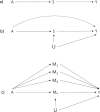Understanding Training Load as Exposure and Dose
- PMID: 37022589
- PMCID: PMC10432367
- DOI: 10.1007/s40279-023-01833-0
Understanding Training Load as Exposure and Dose
Abstract
Various terms used in sport and exercise science, and medicine, are derived from other fields such as epidemiology, pharmacology and causal inference. Conceptual and nomological frameworks have described training load as a multidimensional construct manifested by two causally related subdimensions: external and internal training load. In this article, we explain how the concepts of training load and its subdimensions can be aligned to classifications used in occupational medicine and epidemiology, where exposure can also be differentiated into external and internal dose. The meanings of terms used in epidemiology such as exposure, external dose, internal dose and dose-response are therefore explored from a causal perspective and their underlying concepts are contextualised to the physical training process. We also explain how these concepts can assist in the validation process of training load measures. Specifically, to optimise training (i.e. within a causal context), a measure of exposure should be reflective of the mediating mechanisms of the primary outcome. Additionally, understanding the difference between intermediate and surrogate outcomes allows for the correct investigation of the effects of exposure measures and their interpretation in research and applied settings. Finally, whilst the dose-response relationship can provide evidence of the validity of a measure, conceptual and computational differentiation between causal (explanatory) and non-causal (descriptive and predictive) dose-response relationships is needed. Regardless of how sophisticated or "advanced" a training load measure (and metric) appears, in a causal context, if it cannot be connected to a plausible mediator of a relevant response (outcome), it is likely of little use in practice to support and optimise the training process.
© 2023. The Author(s).
Conflict of interest statement
The authors declare no financial or non-financial conflicts of interest with the contents of the current article.
Figures



References
-
- Fitzpatrick JF, Hicks KM, Hayes PR. Dose-response relationship between training load and changes in aerobic fitness in professional youth soccer players. Int J Sports Physiol Perform. 2018; p. 1–6. - PubMed
Publication types
MeSH terms
LinkOut - more resources
Full Text Sources

